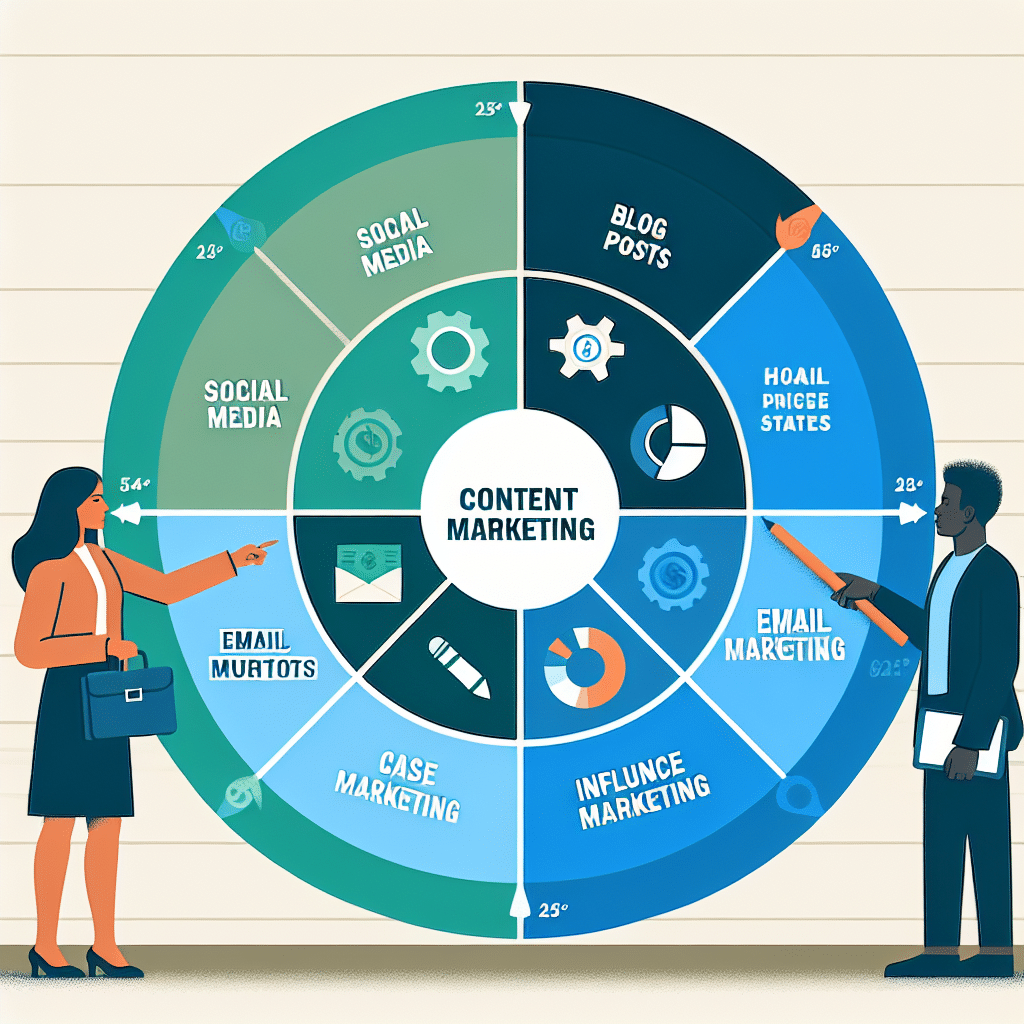Imagine sitting at your desk, fingers poised over the keyboard, but your mind is blank. Ideas swirl around in your head but refuse to settle into coherent thoughts. You write, delete, write, delete… This is a common scenario for many writers, both new starters and experienced ones. The challenge of transforming a chaotic mix of ideas into a structured, engaging blog post can feel overwhelming. Even with a clear idea and confidence in conveying your perspective, your thoughts can quickly become jumbled and coherent with a well-structured blog post outline.
Today, I will explain how to effectively create a blog post outline to streamline your writing process and ensure your content is engaging and well-organized. But first, let’s define what is a blog outline.
What is a Blog Post outline?
Think about it: you have a million thoughts coming and going in your head, and the blank page is supposed to reflect your perspective on a subject. An outline helps navigate this creative chaos, providing structure and direction. It provides the framework for your topics and ideas, ensuring that each element of your post is well-organized and flows logically.
Think of the blog post outline as the backbone of your content—or, better, the brief you give yourself. Writing is not a mechanical process; it is creative. It can take any direction, influenced by your environment, mood, or sudden interruption, like your cat crawling onto your lap or your mom calling.
This brief will keep you in line and allow you to capture your ideas in an organized manner, ensuring that your writing remains focused and coherent despite the inevitable distractions and shifts in inspiration.
Essentially, your outline should cover several key components to ensure a well-structured and engaging blog post:
Overview
This is the part where you should lay out who you are writing for and who you are writing as. Are you writing for yourself or for a company? What will your tone and style be for this blog post?
Laying this information in front of you will keep you in line with your primary purpose while writing your content. It might be a lead magnet, an entertaining post, or a detailed guide. Understanding these foundational elements helps maintain clarity and focus throughout the writing process.
Thinking about these key elements of communication before writing is the first step.
- Target audience
- Key message
- Purpose
- Tone and style
And writing them down in your blog post outline will help.
Keywords

To ensure your target audience finds your blog post through search engines, it’s crucial to research and incorporate relevant keywords. These keywords help search engines understand the content and context of your blog post. Integrate these keywords within the first 100 words of your post to signal the main topic early on. Continue to use them naturally throughout the content to maintain readability and avoid keyword stuffing.
The right keywords can significantly boost your visibility on search engine results pages (SERPs), driving more organic traffic to your site. To identify the relevant keywords, focus on finding keywords with a high search volume but low to moderate competition to maximize your chances of ranking.
You can use tools like ContentGo AI and KeyWord Finder to identify the best keywords.
Introduction
The introduction is your opportunity to capture the reader’s attention and set the tone for the rest of your blog post. Begin with a compelling hook to immediately engage the reader. This could be a surprising fact, a thought-provoking question, or an intriguing anecdote. The aim is to spark curiosity and encourage the reader to continue.
Following the hook, provide context to help the reader understand the topic’s significance. Outline the key points you will cover and explain why they are essential. The introduction should include a clear thesis statement, context for the topic, and an overview of the main points you will discuss in the rest of the post. This structure not only grabs attention but also guides the reader as to what to expect, making your content more engaging and coherent.
Of course, it’s important to remember that outlines are not one-size-fits-all. They can vary significantly from writer to writer. Each person’s thought process is unique, and your approach to outlining will depend on your writing style and familiarity with the subject matter. Nonetheless, this structure aims to be both engaging and effective. Feel free to adapt it to suit your needs while keeping in mind the core principles that make an outline helpful. This flexibility allows you to capture and organize your ideas in a way that best supports your creative process and writing goals.
Titles
Determining the titles and subtitles in your blog post outline makes it feel like you’ve outlined the whole post—at least, that’s how it works for me. Once I settle on the titles, how I approach the subject becomes much clearer. The structure of titles and subtitles acts as a roadmap, guiding both the writing process and the reader’s journey through the content. You should aim for clear and engaging titles to keep readers going and pique curiosity. They convey the value of the content. What do I mean by clear and engaging?
You must have noticed, though, that the majority of the articles you are reading either have action words in their titles, contain figures, or highlight the advantage the user would receive from the content. A precise and descriptive title like “5 Proven Content Marketing Strategies for Small Businesses” is more effective than a vague one like “Marketing Tips.”
Titles and subtitles are also crucial for both SEO and readability. Your titles should contain relevant keywords naturally within your titles. This helps search engines understand the focus of your content, improving its visibility on search engine results pages (SERPs).
Also, Ideally, your main title should be between 50 and 60 characters to ensure it displays fully in search results. Subtitles can be longer but should still be to the point.
Main Points
Now that you have your titles, it’s time to consider how much you will expand each section and what points you will make to support your thesis statement. Instead of delving into too much detail, briefly outline the main points you will cover in each section. This step helps you stay on course and build your overall argument or narrative. By outlining your main points, you ensure that each section of your blog post contributes to a cohesive and well-structured piece, making it easier for readers to follow and understand your message.
Evidence / Examples / Media
To make your blog post more engaging and credible, it’s essential to include evidence, examples, and media. Evidence can come in statistics, research findings, or expert quotes, which lend credibility to your content and make your arguments more convincing. For instance, if you’re writing about the effectiveness of content marketing strategies, you could include data showing how businesses using these strategies have seen significant increases in website traffic or conversion rates.

Generate It ContentGo AI
Your blog post outline should specify the sources you will use for your research, the types of media you will incorporate, and where you can find these resources. Including details about the evidence and examples you plan to use helps you stay organized and ensures you have solid support for your points. Media elements like images, videos, infographics, or charts can break up the text and make your content more visually appealing. They also help explain complex information more clearly and memorably.
By thoughtfully planning and integrating evidence, examples, and media, you can create a richer, more engaging blog post that effectively communicates your message and resonates with your audience. This approach not only enhances your post’s readability but also strengthens your content’s overall impact and credibility.
Conclusion
The conclusion is where you wrap up your article, and it’s likely the part your readers will remember the most. It’s your opportunity to reinforce the key points, provide a final perspective, and leave a lasting impression on your audience.
The conclusion is the article’s last part after the previous subtitle. Briefly summarize the main points you’ve covered in your blog post to outline this part. This reinforces the key takeaways and helps ensure that the reader leaves with a clear understanding of your message. Highlight the most important insights and remind your readers of your content’s value.
Next, offer a final thought or call to action. This part of the blog post outline is one of the most important. It could be a reflection on the topic, a question for the readers to ponder, or a prompt encouraging them to engage further, such as subscribing to your newsletter, leaving a comment, or sharing the post on social media. A compelling call to action can drive engagement and encourage readers to take the next step, which is what you usually want.
Finally, consider ending with a memorable closing sentence. This could be an inspiring quote, a powerful statement, or a hopeful outlook that leaves readers feeling motivated or thoughtful. The goal is to create a strong, positive impression that lingers after they’ve finished reading.
If you want to create a blog post outline quickly you can try ContentGo AI’s blog post outline generator.
Why you need a blog post outline
There are several compelling reasons to plan and create a blog post outline. First and foremost, as I mentioned earlier, breaking down your writing tasks into manageable segments creates a more productive workflow. For instance, the task can initially seem overwhelming if you’re a freelancer facing a 4,000-word article. However, once you outline your blog post, it becomes much easier to tackle each section and thoughtfully consider each part.
An outline provides a clear roadmap for your writing, helping you stay organized and focused. It ensures that all your main points are covered and logically structured, which enhances the overall coherence and flow of your content. This is especially important for lengthy articles, where losing track of your main argument is easy without a clear plan.
Additionally, an outline helps ensure your content is comprehensive and balanced. By laying out your main points and subpoints in advance, you can see the entire structure and identify any gaps or areas that need further development. This prevents the common pitfall of focusing too heavily on one aspect of your topic while neglecting others.
Outlining also saves you time in the long run. While it might seem like an extra step initially, it streamlines the writing process by providing a clear direction and reducing the need for extensive revisions. With a well-crafted outline, you can write more efficiently and with greater confidence, knowing that each section of your post serves a specific purpose and contributes to your overall argument

Generate It ContentGo AI
Let’s consider another scenario where you are a content marketing specialist for a large company. In this role, you will likely collaborate with a team of content writers responsible for crafting each blog post. Providing them with a clear outline allows them to align better with your overall content marketing strategy, ultimately driving more leads and improving the effectiveness of your efforts.
As the person responsible for creating the strategy and content plan, you can outline several posts in advance for the writers to develop. This ensures consistency in tone and style and guarantees that each post serves a specific purpose within your broader marketing objectives. By giving your writers detailed outlines, you help them understand the key messages, target audience, and desired outcomes for each post, which leads to more cohesive and impactful content.
Moreover, clear outlines streamline the writing process, making it easier for writers to produce high-quality content efficiently. This efficiency can lead to faster turnaround times and the ability to publish more frequently, crucial for maintaining engagement and visibility in today’s fast-paced digital landscape. Ultimately, detailed outlines foster better collaboration, enhance the quality of your content, and contribute to the success of your content marketing strategy.
Steps of Blog Post Outline Creation
Great! Now that you understand the components of a blog post outline’s components, purpose, and benefits, it’s time to implement this knowledge. We will walk through the process of creating and outlining a blog post step by step.
Let’s get into it.
Choose your topic
Choosing your blog post topic is a crucial part of your content strategy. Whether you aim to generate leads, build brand authority, or drive sales, choosing topics that align with these goals ensures your content contributes to your overall strategy.
For instance, a blog post that educates readers about your products or services can help nurture potential customers through the sales funnel. If you are creating a content plan, you likely outline your topics way before you write them or even start to craft the blog post outline individually. To choose the best topics to serve your strategy, understand what your target audience cares about. What questions do they have? What problems are they looking to solve?
You can use tools like Google Trends, Answer the Public, or social media platforms to discover trending topics and common queries within your niche.
Do a quick SERP analysis

For a better experience, you can use ContentGo AI’s SERP tool.
A SERP analysis can help you understand what content is currently ranking for your chosen topic. This insight allows you to identify gaps, understand what works, and find opportunities to create better content. For example, by looking at the top results, you can choose the best format to meet user expectations and preferences from the types of content that are performing well, whether they are blog posts, videos, infographics, or something else.
You might come across a content opportunity that hasn’t been seized. The top articles may lack specific case studies or detailed step-by-step guides. You can include these elements to make your content stand out.
The existing content may be high-quality and well-researched, and if so, you must match or exceed this standard to attract and retain readers. Also, by doing a SERP analysis, you will understand the common themes and keywords driving traffic to these top-ranking pages.
Find your keywords
The next step is finding your keywords. After choosing your topic and doing a SERP analysis, you probably have identified some keywords that might drive traffic. But you might have missed some. Keyword research tools like Google Keyword Planner or ContentGo KW Finder will help you identify the low-competition, high-ranking keywords. Those keywords are the ones you should go for. These are usually the long-tail keywords.
They can attract more targeted traffic and are typically easier to rank for. For example, instead of targeting “content marketing,” you might use “effective content marketing strategies for small businesses.”
Also, remember to align with your target audience’s search intent. Are they looking for information, wanting to purchase, or seeking a solution to a problem? Tailor your keywords to match this intent.
Choose a format
After choosing your topic, doing a SERP analysis, and finding your keywords, the next step is determining the best content format for your topic. Different topics lend themselves to various formats, and choosing the right one can make your content more engaging and effective. Think about what format will best convey your message and engage your audience. Consider whether a format hasn’t been published yet, which could provide a fresh and unique perspective on the topic.
For example, an infographic or video might be the best format if your topic is highly visual. A comprehensive guide or a series of blog posts might be more suitable if it’s a complex subject that requires detailed explanations. Alternatively, a list or a how-to post could be ideal if your audience prefers quick and actionable insights.
Choosing the suitable format also involves considering your resources and capabilities. If you have the skills and tools to create high-quality videos or infographics, leveraging these formats can enhance your content. However, a well-structured blog post or e-book might be the best choice if you’re more comfortable writing.
Determine the specific focus of your content
Alright, you have your topic, keywords, and format. Let’s examine this through an example. Suppose you will write about “how to grow a garden.” Your keywords might include “garden tips,” “beginner gardening,” and “easy gardening methods.” You decide to create a detailed blog post with step-by-step instructions. That still needs to be more specific.
Instead, you could focus on “how to grow an herb garden in small spaces.” This specific focus caters to a niche audience and allows you to provide detailed insights on plant selection, container gardening techniques, and space optimization for small areas. This specific focus makes your content more targeted and valuable to readers interested in urban gardening or those with limited space.
How can you determine this, or will it matter which focus? Well, it will change the quality and uniqueness of your article. You can choose your focus based on what your audience cares about most, your expertise level and passion on the subject, and available resources that you can research.
Create your title and subtitles
This is the part where your blog post outline truly takes shape. After determining your titles based on keywords and your specific focus, your sections and how you will present your perspective will be nearly set.
Figure out the main points you want to make in each section
This is the part where you brainstorm different points of view and ideas for each section to make your article interesting and engaging. You can outline what you will research for each main point and add links to your outline to read them at the next step. Also, don’t forget to outline and figure out what you want to convey in the introduction and conclusion.

Generate It ContentGo AI
Research what you want to read and get inspired from before creating your blog post
Researching is the most crucial step before diving into writing. This process helps you gather relevant information, find inspiration, and ensure that your content is accurate and valuable. As you research, you’ll continually add to your outline, enhancing the depth and richness of your article.
Do research for the statistics, the examples, and the media you want to use
You can add the statistics and the examples as you write or after you write; however, if you do it in advance, your article will be shaped, and you will build your arguments better, as you will have the examples, statistics, or media. These will shape your article and inspire you as you continue writing.
